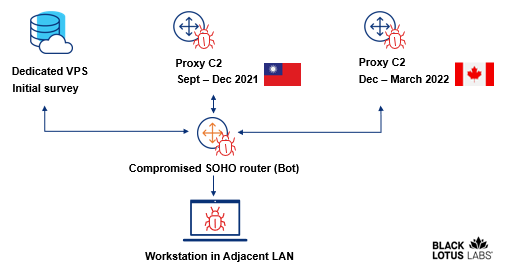[ad_1]

Getty Pictures
An unusually sophisticated hacking group has invested practically two yrs infecting a wide assortment of routers in North The usa and Europe with malware that usually takes comprehensive regulate of related devices functioning Windows, macOS, and Linux, researchers documented on Tuesday.
So far, researchers from Lumen Technologies’ Black Lotus Labs say they have discovered at least 80 targets infected by the stealthy malware, infecting routers produced by Cisco, Netgear, Asus, and DayTek. Dubbed ZuoRAT, the remote accessibility Trojan is part of a broader hacking marketing campaign that has existed considering that at the very least the fourth quarter of 2020 and carries on to function.
A significant degree of sophistication
The discovery of customized-built malware penned for the MIPS architecture and compiled for smaller workplace and residence workplace routers is sizeable, especially offered its variety of capabilities. Its ability to enumerate all devices connected to an contaminated router and accumulate the DNS lookups and network traffic they send out and obtain and remain undetected is the hallmark of a highly subtle threat actor.
“Even though compromising SOHO routers as an access vector to acquire accessibility to an adjacent LAN is not a novel strategy, it has rarely been documented,” Black Lotus Labs scientists wrote. “Equally, reviews of individual-in-the-center design attacks, these as DNS and HTTP hijacking, are even rarer and a mark of a advanced and qualified operation. The use of these two strategies congruently shown a higher stage of sophistication by a danger actor, indicating that this marketing campaign was probably carried out by a state-sponsored firm.”
The marketing campaign contains at minimum four parts of malware, a few of them penned from scratch by the danger actor. The to start with piece is the MIPS-based mostly ZuoRAT, which carefully resembles the Mirai Internet of Things malware that realized document-breaking distributed denial-of-provider attacks that crippled some Online providers for days. ZuoRAT often gets mounted by exploiting unpatched vulnerabilities in SOHO units.
Once put in, ZuoRAT enumerates the devices connected to the infected router. The danger actor can then use DNS hijacking and HTTP hijacking to bring about the linked units to set up other malware. Two of all those malware pieces—dubbed CBeacon and GoBeacon—are custom made-manufactured, with the first written for Home windows in C++ and the latter penned in Go for cross-compiling on Linux and macOS equipment. For adaptability, ZuoRAT can also infect connected products with the greatly employed Cobalt Strike hacking software.

Black Lotus Labs
ZuoRAT can pivot infections to connected devices applying one particular of two procedures:
- DNS hijacking, which replaces the legitimate IP addresses corresponding to a area such as Google or Fb with a destructive a person operated by the attacker.
- HTTP hijacking, in which the malware inserts itself into the link to make a 302 error that redirects the person to a various IP tackle.
Deliberately elaborate
Black Lotus Labs stated the command and regulate infrastructure utilised in the marketing campaign is deliberately complex in an attempt to conceal what is actually happening. 1 set of infrastructure is applied to command infected routers, and yet another is reserved for the connected units if they are later on contaminated.
The researchers noticed routers from 23 IP addresses with a persistent link to a manage server that they believe that was accomplishing an first study to determine if the targets were of desire. A subset of those 23 routers later on interacted with a Taiwan-dependent proxy server for a few months. A further more subset of routers rotated to a Canada-based mostly proxy server to obfuscate the attacker’s infrastructure.
This graphic illustrates the ways stated involved.

The danger actors also disguised the landing page of a command server to glance like this:

Black Lotus Labs
The researchers wrote:
Black Lotus Labs visibility implies ZuoRAT and the correlated exercise characterize a extremely focused marketing campaign versus US and Western European organizations that blends in with standard internet traffic through obfuscated, multistage C2 infrastructure, probable aligned with several phases of the malware infection. The extent to which the actors choose pains to disguise the C2 infrastructure simply cannot be overstated. Initial, to stay away from suspicion, they handed off the original exploit from a focused digital non-public server (VPS) that hosted benign content. Following, they leveraged routers as proxy C2s that hid in basic sight as a result of router-to-router interaction to more avoid detection. And at last, they rotated proxy routers periodically to prevent detection.
The discovery of this ongoing marketing campaign is the most critical a person influencing SOHO routers considering the fact that VPNFilter, the router malware established and deployed by the Russian government that was discovered in 2018. Routers are often ignored, notably in the perform-from-home period. Although organizations typically have stringent requirements for what devices are allowed to hook up, several mandate patching or other safeguards for the devices’ routers.
Like most router malware, ZuoRAT can not endure a reboot. Just restarting an contaminated device will get rid of the initial ZuoRAT exploit, consisting of information stored in a short term listing. To entirely recover, even so, contaminated devices should be manufacturing facility reset. Sadly, in the party related gadgets have been infected with the other malware, they cannot be disinfected so conveniently.
[ad_2]
Source website link